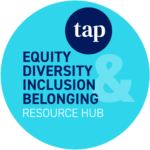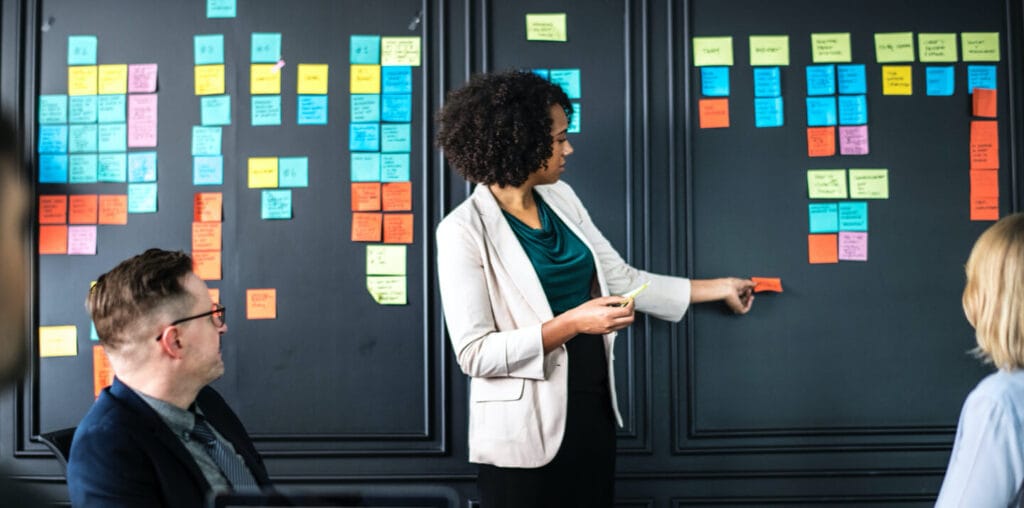EDI&B Maturity Levels
The 5 Stages of the EDI&B Journey


Compliance
The compliance stage is where most organizations begin their EDI&B journeys. The organization is generally meeting legal requirements, but has only taken preliminary steps towards creating an inclusive culture.
Discovery
The discovery stage often begins when an organization identifies and seeks to address a gap in their EDI&B practices. They may form a strategy to improve representation on their team by diversifying candidate pipelines and reviewing retention…


Committed
The committed stage marks the implementation of an organization wide strategy. At this point in their journey, organizations start embedding EDI&B into all aspects of their business and operations, and increase their focus on inclusive culture.
Championed
Organizations at the championed stage have strong support from their leadership teams and staff for progress on their EDI&B goals. Many have effective initiatives underway and want to measure progress, so benchmarking is a key priority at this stage.


Innovation
At the innovation stage, an organization’s inclusive culture is a pillar of their employer brand. EDI&B is embedded across the organization– reflecting best practices. They share their tools with others and aim to deepen staff and community development…
Take The Self-Assessment Quiz
The following self-assessment will provide a snapshot of your organization’s current position on the equity, diversity, inclusion, and belonging journey along the maturity model continuum. The questions are meant to provide you with a quick representation of the strengths that your organization exhibits and the opportunities for improvement. Your score will allow you to be positioned on the maturity continuum and will be accompanied by a few resource recommendations that will support you on the pathway to the next stage of your journey.
For each question, chose one of the following answers:
A. Strongly agree
B. Agree
C. Neutral
D. Disagree
E. Strongly disagree
The majority of our leadership team and staff feel that our organization should address diversity and inclusion.
A. Strongly agree
B. Agree
C. Neutral
D. Disagree
E. Strongly disagree
There is a clear plan with actionable steps in place to improve diversity and inclusion at our organization.
A. Strongly agree
B. Agree
C. Neutral
D. Disagree
E. Strongly disagree
There is a sense of safety around expressing staff identities in the workplace.
A. Strongly agree
B. Agree
C. Neutral
D. Disagree
E. Strongly disagree
People can honor their cultural holidays.
A. Strongly agree
B. Agree
C. Neutral
D. Disagree
E. Strongly disagree
We regularly (e.g.: once per quarter) survey employees on workplace culture and satisfaction.
A. Strongly agree
B. Agree
C. Neutral
D. Disagree
E. Strongly disagree
Staff social activities are planned to accommodate various lifestyles, abilities and interests.
A. Strongly agree
B. Agree
C. Neutral
D. Disagree
E. Strongly disagree
The composition of our leadership team represents the staff and the communities they serve.
A. Strongly agree
B. Agree
C. Neutral
D. Disagree
E. Strongly disagree
All staff are trained on how to implement and respect anti-harassment and bullying policies.
A. Strongly agree
B. Agree
C. Neutral
D. Disagree
E. Strongly disagree
We access underrepresented candidates through partnerships and designated group specific organizations (e.g.: organizations serving immigrants and refugees, women, Indigenous, 2SLGBTQQIA+, people with disabilities, and people of colour).
A. Strongly agree
B. Agree
C. Neutral
D. Disagree
E. Strongly disagree
Our interview process requests that candidates disclose disabilities so that accommodations can be made.
A. Strongly agree
B. Agree
C. Neutral
D. Disagree
E. Strongly disagree
We have implemented the Truth and Reconciliation recommendations for the workplace.
A. Strongly agree
B. Agree
C. Neutral
D. Disagree
E. Strongly disagree
Our executives have already put practices in place to include all of the following equity seeking groups: Indigenous, 2SLGBTQQIA+, Newcomers to Canada, people of colour, people with disabilities, and women?
A. Strongly agree
B. Agree
C. Neutral
D. Disagree
E. Strongly disagree
Count the number of times you chose each of the following responses:
A. Strongly agree
B. Agree
C. Neutral
D. Disagree
E. Strongly disagree
Multiply the number of times you answered:
Strongly agree by 5
Agree by 4
Neutral by 3
Disagree by 2
Strongly disagree by 1
Add the numbers.
The total positions you at one of the maturity model stages
12 - 20 Compliance
Organizations in the compliance stage are generally following all legal requirements mandated by the provincial and federal levels of government. Organizations are working to ensure safe working conditions and are providing the minimum level of benefits required by law.
- Anti Harassment Policy: Writing an Effective Anti-Harassment Policy
- Tool #7: Maintaining Successful Employment: Strategies for retaining staff such as: workplace training, creating effective and inclusive workplaces, availability of accommodations, work-life balance and ensuring that employees understand their job requirements.
- Getting started with DE&I: A starting point to developing a diversity & inclusion strategy.
21 - 30 Discovery
A great start! Organizations at the Discovery stage recognize there is a problem or potential to grow. Often, these organizations have identified an organizational culture issue, a high turnover rate, or had concerns and suggestions brought forward by their employees. Discovery is a great time to implement some quick wins and see what can be done right away to build momentum.
- Creating Barrier-Free Job Descriptions: Tip sheet with information on creating job descriptions that will help to attract new immigrant talent to your workplace.
- Reconciliation Resources: Resources to support organizations in supporting Indigenous employees.
- Waiter, Is That Inclusion in My Soup, a New Recipe to Improve Business Performance: Creating a strong business case for inclusion.
31 - 40 Committed
Wonderful! A committed organization usually has committed resources in terms of people, money and time towards diversity and inclusion. A committed organization is usually in the first few years of their DE&I journey and has a few programs and initiatives in place. Some are well on their way to reaching the next stage.
- A Practical Kit to help Employers build an inclusive workplace: The Mental Health Commission has created this resource to support HR professionals build a culture to support those living with mental health disabilities.
- CCDI Toolkit: Addressing fear and resistance: Toolkit with practical suggestions and strategies for dealing with fear and resistance to diversity and inclusion initiatives in your organization.
- Diversity, Equity and Inclusion for remote teams: Engagement is as important for remote employees.
41 - 50 Championed
Excellent! In an organization at the Championed stage, the leadership team is most likely very engaged in the development of a diversity, equity & inclusion strategy and its execution. These organizations are leading initiatives and are advocating for new programs and processes to support clear DE&I goals.
- CCDI Toolkit: Locking in your leadership: Developing the ironclad business case for diversity and inclusion
- National Diversity and Inclusion Benchmarking Study: Senior Leaders and Diversity Personnel: A national benchmarking resource that aids Canadian organizations in assessing their D&I development.
- Creating Authentic Spaces: Toolkit to help allies challenge transphobia and to foster environments that are inclusive of gender identity and gender expression.
51 - 60 Innovation
Congratulations! Your organization is most likely leading the way in your industry in terms of diversity, equity and inclusion practices. Perhaps you can expand your DE&I impact beyond your organization and by ensuring you support each of the 5 designated groups.
- Supplier Diversity in Canada: A guideline for exploring supplier diversity to promote diversity in the value chain.
- Diversity Staffing Structures: Examining current practices in the area of diversity staffing.
- What Gets Measured Gets Done: Measuring the Return on Investment of Diversity and Inclusion: Report on the best practices in measurement on D&I initiatives.

